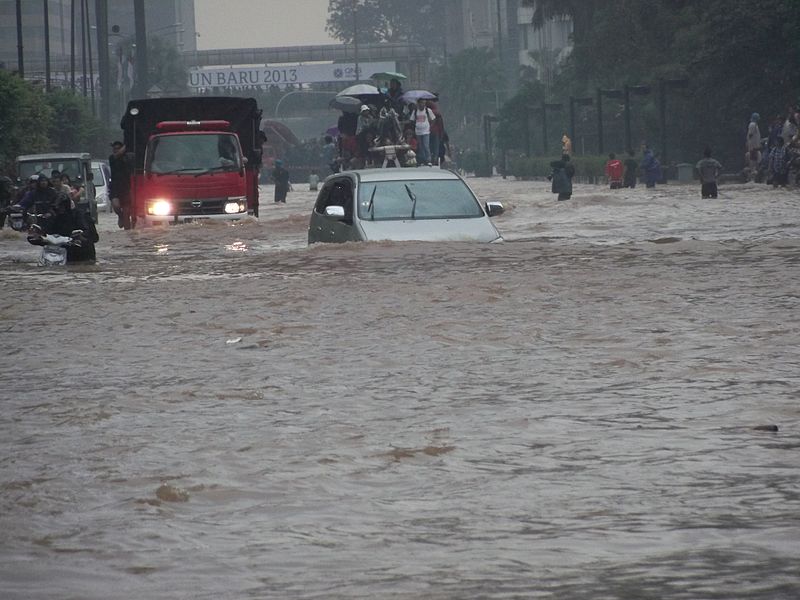The gist of the study is that in some cities, subsidence is now exceeding sea level rise.
It is something to think about and cite the next time there is an alarming story about sea level "inundating" some city with a coastal flood.
Here are some excerpts and an abstract:
Forget global warming and melting polar caps - groundwater extraction is causing cities to SINK beneath sea level:
Read more: http://www.dailymail.co.uk/sciencetech/article-2616714/Forget-global-warming-groundwater-extraction-causing-megacities-SINK-beneath-sea-level.html#ixzz30SUGdrxy
- Ground is dropping up to 10 times faster than the sea level is rising in coastal megacities, a new study says
- Scientists at Deltares Research Institute in Utrecht studied subsidence in five coastal cities, including Jakarta, New Orleans and Bangkok
- North Jakarta has sunk four metres in the last 35 years - a fall of 10 to 20cm per year and experts have called on governments to take action
- Land subsidence is contributing to larger, longer and deeper floods
- Total damage due to subsidence worldwide is estimated at billions of dollars a year and is set to increase
I located the abstract for the research:
Sinking coastal cities
Dr. Gilles Erkens, Deltares | Utrecht University
G. Erkens, Deltares Research Institute, Utrecht, The Netherlands and Faculty of Geoscience, Utrecht University, Utrecht, The Netherlands, T. Bucx, Deltares Research Institute, Utrecht, The Netherlands
R. Dam, Deltares Research Institute, Utrecht, The Netherlands
G. de Lange, Deltares Research Institute, Utrecht, The Netherlands
J. Lambert Deltares Research Institute, Utrecht, The Netherlands
Abstract
In many coastal and delta cities land subsidence now exceeds absolute sea level rise up to a factor of ten. A major cause for severe land subsidence is excessive groundwater extraction related to rapid urbanization and population growth. Without action, parts of Jakarta, Ho Chi Minh City, Bangkok and numerous other coastal cities will sink below sea level. Land subsidence increases flood vulnerability (frequency, inundation depth and duration of floods), with floods causing major economic damage and loss of lives. In addition, differential land movement causes significant economic losses in the form of structural damage and high maintenance costs. The total damage worldwide is estimated at billions of dollars annually. As subsidence is spatially different and can be caused by multiple processes, an assessment of subsidence in delta cities needs to answer questions such as: what are the main causes, how much is the current subsidence rate and what are future scenarios (and interaction with other major environmental issues), where are the vulnerable areas, what are the impacts and risks, how can adverse impacts can be mitigated or compensated for, and who is involved and responsible to act? In this study a quick-assessment of subsidence is performed on the following mega-cities: Jakarta, Ho Chi Minh City, Dhaka, New Orleans and Bangkok. Results of these case studies will be presented and compared, and a (generic) approach how to deal with subsidence in current and future subsidence-prone areas is provided.
Geophysical Research Abstracts Vol. 16, EGU2014-14606, 2014 EGU General Assembly 2014 © Author(s) 2014. CC Attribution 3.0 License. Sinking coastal cities Gilles Erkens (1,2), Tom Bucx (1), Rien Dam (1), Ger De Lange (1), and John Lambert (1) (1) Deltares Research Institute, Utrecht, The Netherlands, (2) Faculty of Geosciences, Utrecht University, Physical Geography, Utrecht, The Netherlands (g.erkens@geo.uu.nl)
In many coastal and delta cities land subsidence now exceeds absolute sea level rise up to a factor of ten. Without action, parts of Jakarta, Ho Chi Minh City, Bangkok and numerous other coastal cities will sink below sea level. Land subsidence increases flood vulnerability (frequency, inundation depth and duration of floods), with floods causing major economic damage and loss of lives. In addition, differential land movement causes significant economic losses in the form of structural damage and high maintenance costs. This effects roads and transportation networks, hydraulic infrastructure - such as river embankments, sluice gates, flood barriers and pumping stations -, sewage systems, buildings and foundations. The total damage worldwide is estimated at billions of dollars annually. Excessive groundwater extraction after rapid urbanization and population growth is the main cause of severe land subsidence. In addition, coastal cities are often faced with larger natural subsidence, as they are built on thick sequences of soft soil. Because of ongoing urbanization and population growth in delta areas, in particular in coastal megacities, there is, and will be, more economic development in subsidence-prone areas. The impacts of subsidence are further exacerbated by extreme weather events (short term) and rising sea levels (long term). Consequently, detrimental impacts will increase in the near future, making it necessary to address subsidence related problems now. Subsidence is an issue that involves many policy fields, complex technical aspects and governance embedment. There is a need for an integrated approach in order to manage subsidence and to develop appropriate strategies and measures that are effective and efficient on both the short and long term. Urban (ground)water management, adaptive flood risk management and related spatial planning strategies are just examples of the options available. A major rethink is needed to deal with the 'hidden' but urgent threat of subsidence. As subsidence is spatially different and can be caused by multi processes, an assessment of subsidence in delta cities needs to answer questions such as: what are the main causes, how much is the current subsidence rate and what are future scenarios (and interaction with other major environmental issues), where are the vulnerable areas, what are the impacts and risks, how can adverse impacts can be mitigated or compensated for, and who is involved and responsible to act? In this study a quick-assessment of subsidence is performed on the following mega-cities: Jakarta, Ho Chi Minh City, Dhaka, New Orleans and Bangkok. Results of these case studies will be presented and compared, and a (generic) approach how to deal with subsidence in current and future subsidence-prone areas is provided.




Subsidence is just a theory.